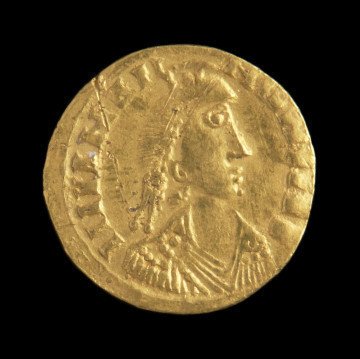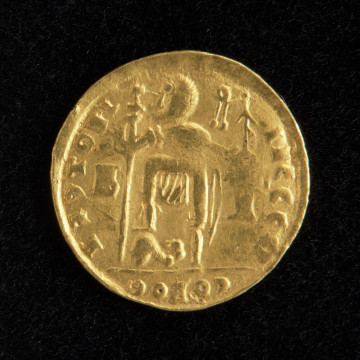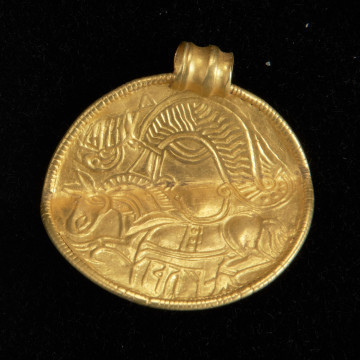
Gold coin
425 — 455
National Museum in Szczecin
Part of the collection: Antiquity
The golden solidus of Emperor Zeno the Isaurian, a fragment of a hoard discovered before 1826, was found in the vicinity of Malechowo. A spiral ring and another solidus (of Theodosius II, minted in Ravenna or Milan in 423, which was probably the Ostrogothic imitation of Anastasius I solidi from the beginning of the 6th century) were found underneath the same granite block. The coins were acquired by the Pomeranian History and Antiquities Society, which collections constitute a considerable part of the current collections of archaeological objects of the National Museum in Szczecin. The coin was minted in Constantinople between 476–491. The obverse represents the Emperor Zeno bust, wearing a diadem on his head, and armour on his chest. In his right hand he holds a spear, which rests on his right shoulder. On the left side you can see a fragment of a shield. Around it, there is the inscription DN ZENO PERP AVG. The reverse of the coin depicts a winged figure of Victoria, turned to the right. The goddess’s right hand holds a long, decorative cross. A six-pointed star is illustrated on the left. Around the figure, there is the inscription VICTORIA AUGGG, and underneath the goddess’s feet the word CONOB. Solidi, along with silver and bronze coins, were a basic currency used for trade in the Mediterranean Sea basin until the 11th century. The coin influx on the Barbaricum territories (European areas outside the Roman Empire boundaries) occurred through the trade contacts of tribes’ elites and through Roman tributes paid to the tribes that invaded the Empire.
Monika Witek
Author / creator
Dimensions
cały obiekt:
Object type
exchaneg media; money; coin; solidus
Technique
forming; punching
Material
gold
Creation time / dating
Creation / finding place
Owner
Muzeum Narodowe w Szczecinie
Identification number
Location / status

425 — 455
National Museum in Szczecin

441 — 450
National Museum in Szczecin

National Museum in Szczecin
DISCOVER this TOPIC
Castle Museum in Łańcut
DISCOVER this PATH
Educational path